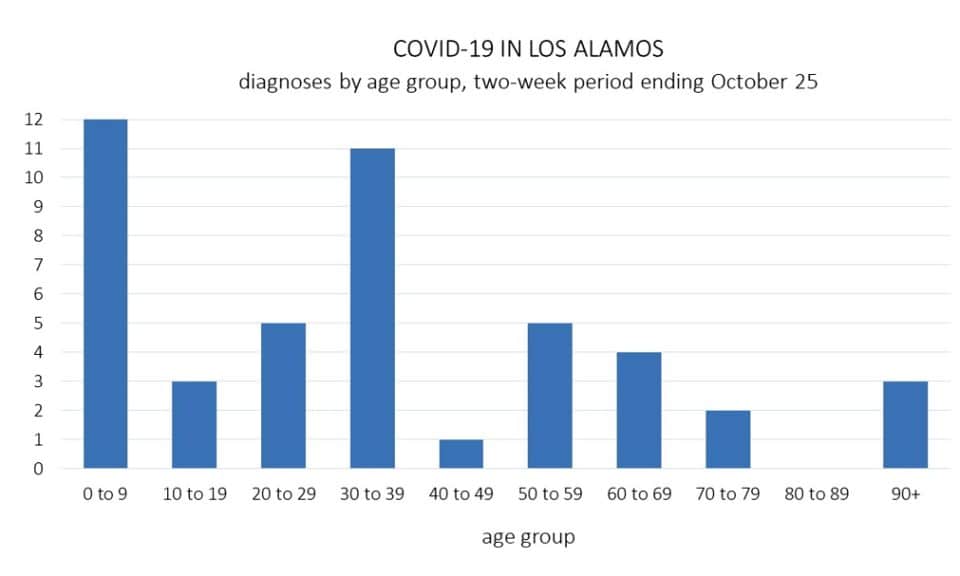 By RICHARD SKOLNIK
By RICHARD SKOLNIKLos Alamos
Editor’s Note: This is the fifth in a series of COVID-19 Updates by Richard Skolnik that appear bi-weekly in the Los Alamos Daily Post. These are meant to keep the community informed on the status of the pandemic, critical new findings on the pandemic, and what this information suggests for our community’s response to COVID-19. These updates complement the data that Eli Ben-Naim prepares for the Post. Unless otherwise noted, data is from the New York Times and the New Mexico Department of Health.
Pandemic Data and Trends – For the Week Ending Oct. 25, 2021
In the US, cases declined by 22%, hospitalizations by 18%, and deaths by 11% over the last two weeks. The daily average of new cases in the US over the last week was about 70,000, with a daily average rate of 21 cases per 100,000. Despite the overall decline, 14 states saw a rising rate of infections over the last two weeks.
Over the last two weeks, the daily average of new cases rose in New Mexico by 66%, the highest rate of increase in the country. Hospitalizations rose by 9% and deaths rose by 30%. The daily average number of cases over the last week was 797, with a rate of 38 per 100,000. Almost 72% of all New Mexicans over age 18 have been fully vaccinated.
Los Alamos had a daily average over the last week of about 2 cases and a rate of 10 per 100,000 population. This was a decrease of 67% over the last two weeks. The age distribution of new cases (thanks to Eli Ben-Naim) over the last two weeks is shown in the graphic below. Almost 91% of the adults over 18 in Los Alamos have been fully vaccinated.

Important Pandemic Information
New Mexico hospitals continue to operate under Crisis Standards of Care, a framework for rationing care.
New Mexico has reached 5,000 COVID-related deaths. COVID is the second leading cause of death to date in the US in 2021.
The US approved boosters for select groups of people for the Moderna vaccine. Boosters were also approved for anyone who got the J&J vaccine. “Mixing and matching” of vaccines was also approved.
The FDA’s independent panel of expert advisers has endorsed approval of the Pfizer vaccine for for emergency use authorization for children ages 5-11.
There were almost 118,000 cases among children in the week ending October 21, in the states that report. This was a decline from about 131,000 in the previous week. A large (BMJ pre-print) study of children and adolescents in the UK who caught SARS-CoV-2 has found that as many as one in seven (14%) may still have symptoms 15 weeks later.
If you are not fully vaccinated in NM, your risk of being infected, hospitalized, and dying is 4.5 times, 6.0 times, and 11.7 times greater than if you are fully vaccinated.
Despite the effectiveness of monoclonal antibodies in preventing high-risk patients from progressing to severe COVID, data suggest that there are major gaps throughout the US in primary care physician knowledge of such therapy, access to this therapy, and the staff and logistics needed to carry it out appropriately.
What Do We need to Do in Los Alamos?
The large spike we saw in cases has disappeared. Our daily case count has returned to the relatively low level it had been at for some time. The case counts over the last month suggest what can happen when a small number of people are infected and the virus spreads. They also highlight the importance of continued implementation of vaccination and of mitigation measures within schools, within families, and in the community.
In 20 months since the pandemic began, we have seen no published information from any governmental authority about the sources of spread of the virus in Los Alamos. This is despite the fact that such information is normally the foundation of a public health response. In the absence of this information, we have no ability to “fine tune” our approach to COVID and must continue to rely on the combination approach to mitigation we have been taking.
The small number of cases in our schools suggests that the LAPS deserves considerable praise for the quality of its response to COVID so far. The rate of infections in our schools has been remarkably low compared to many places in the US. However, we need to prepare not only for today, but also for what might happen tomorrow and the next day. Thus, it is also important that surveillance testing in our schools begin as rapidly and as fully as possible.
There are now options for getting a booster in town that fall outside of the NMDOH vaccine registration system. Thus, it would be extremely useful for the county to provide additional guidance on what options there are for people to get their boosters in Los Alamos. This should include in one place, upcoming community vaccine events, where people can schedule a vaccine using the state vaccine registration system, where they can directly schedule a vaccine, and where they can get a vaccine as a walk-in. There are widespread reports this week of people spending considerable time “shopping” for vaccines and getting conflicting information from suppliers as they did so. Members of the community will need to carefully check when they make an appointment or walk-in for a vaccine that the supplier to whom they are going has the vaccine they want.
Editor’s Note: Richard Skolnik is the former regional director for health for South Asia at the World Bank. He was the director of an AIDS treatment program for Harvard and taught Global Health at the George Washington University and Yale. He is the author of Global Health 101 and the instructor for Yale/Coursera’s Essentials of Global Health. Skolnik has written this article in his personal capacity.

